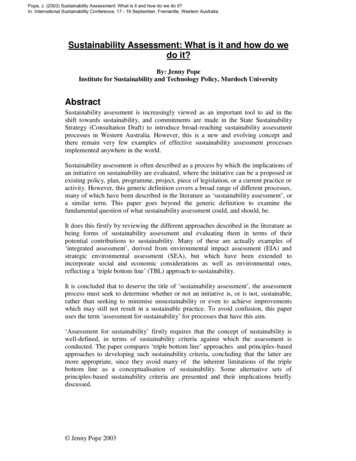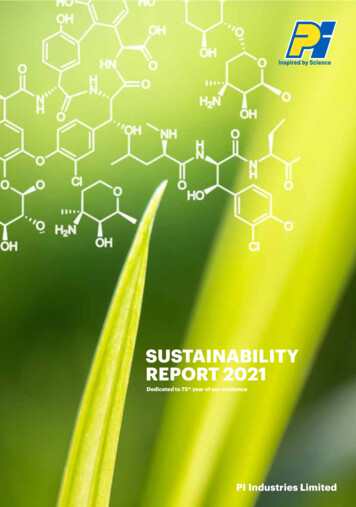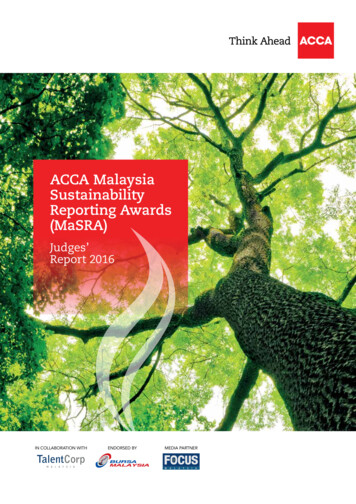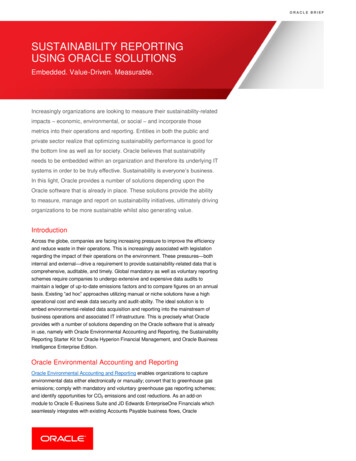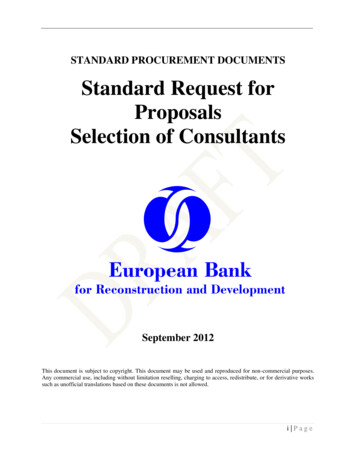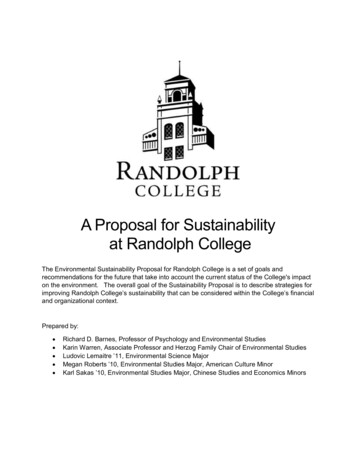
Transcription
A Proposal for Sustainabilityat Randolph CollegeThe Environmental Sustainability Proposal for Randolph College is a set of goals andrecommendations for the future that take into account the current status of the College's impacton the environment. The overall goal of the Sustainability Proposal is to describe strategies forimproving Randolph College’s sustainability that can be considered within the College’s financialand organizational context.Prepared by: Richard D. Barnes, Professor of Psychology and Environmental StudiesKarin Warren, Associate Professor and Herzog Family Chair of Environmental StudiesLudovic Lemaitre ’11, Environmental Science MajorMegan Roberts ’10, Environmental Studies Major, American Culture MinorKarl Sakas ’10, Environmental Studies Major, Chinese Studies and Economics Minors
Page 2ContentsContents. 2Why an Environmental Sustainability Proposal?. 4Environmental Sustainability Initiatives at Randolph College . 6Goals of the Environmental Sustainability Proposal Overview . 8Goal 1: Facilities and Operations . 9Objective 1A: Land Use. 10Objective 1B: Buildings . 12Objective 1C: Landscaping. 13Objective 1D: Infrastructure and Energy Use . 14Objective 1E: Purchasing . 15Objective 1F: Materials Management and Recycling. 16Objective 1G: Dining Services . 17Objective 1H: Transportation and Power Equipment . 18Goal 2: Education, Communication, and Research . 19Objective 2A: Curriculum . 20Objective 2B: Research. 21Objective 2C: Faculty and Staff Development . 22Objective 2D: Communication . 23Objective 2E: Co-Curricular Education . 24Objective 2F: A Campus Culture of Sustainability . 25Goal 3: College Structures, Administration and Leadership . 26Objective 3A: Organizational Structures . 27Objective 3B: Environmental Leadership . 28Objective 3C: Facilities Planning . 29
Page 3Goal 4: Community Outreach. 30Objective 4A: Community Resource . 32Objective 4B: Collaboration with Other Colleges . 33Summary and Conclusions . 34Appendix A:The Talloires Declaration University Leaders for a Sustainable Future . 35Appendix B:The American College & University Presidents’ Climate Commitment . 37Appendix C:Environmental Issues Council . 39Appendix D:Overview of Sustainability Initiatives at Other Colleges and Universities . 40Appendix E:Overview of Greenhouse Gas Inventory . 42
Page 4Why an EnvironmentalSustainability Proposal?Did you know?Randolph College produces An environmental sustainability proposalis a tool that many colleges and universities use7,300 Metric Tons of CO2to maximize the efficiency of their energy andEquivalent*resource use while decreasing their ecological235 T of Physical Wastefootprint. Randolph College's impact on thenatural environment must be taken into account and uses when considering the overall sustainability of17.7 Million Gallons of Waterthe College. Every member of the Collegecommunity influences the natural world in ways110,000 MMBtu of Energythat they consume products and create waste2,000 lbs of Synthetic Fertilizerfrom what they use. This use and emission ofbyproducts from the consumption of goods has ALL in 1 year.an impact on the quality of our surroundingenvironments. The individual human impact isknown as an ecological footprint, which*Includes other greenhouse gases suchrepresents the amount of land necessary toas methane and nitrous oxide .support a person's lifestyle. Randolph Collegealso has an ecological footprint that is affectedby its energy use, water consumption, landholdings, emissions from energy consumption (greenhouse gas emissions), andphysical and chemical waste. This footprint can be reduced through efforts by theCollege to become more sustainable, as well as through land holdings that can serve asan offset to carbon emissions because vegetation naturally captures CO2 molecules outof the atmosphere.The Environmental Sustainability Proposal for Randolph College is a set ofgoals and recommendations for the future that take into account the currentstatus of the College's impact on the environment. It includes aspects of thecollege such as buildings, transportation, utilities, landscaping, education and research,as well as overall implementation of the goals and recommendations (as carried outthrough the administration and the Environmental Issues Council). The overall goal ofthe Environmental Sustainability Proposal is to describe strategies for improvingRandolph College’s sustainability that can be considered within the College’sfinancial and organizational context.Sustainability can be defined as the improvement of the quality of life withoutcompromising the earth for future generations, or “development that meets the needs ofthe present without compromising the ability of future generations to meet their ownneeds” (Brundtland Commission). Robert Gillman, editor of In Context magazine, notesthat "sustainability refers to a very old and simple concept (The Golden Rule).do untofuture generations as you would have them do unto you." Many colleges are working toimplement sustainability on their campuses (see Appendix D). The University ofVirginia has conducted a thorough report on their current environmental status and is
Page 5implementing measures to become more sustainable. Others, such as Middlebury andLongwood Colleges, have created a position of Sustainability Coordinator on theircampus staff or within their administration that oversees and coordinates allsustainability efforts on the campus. These colleges serve as examples to theirsurrounding communities and other colleges and institutions. In 2006, the Associationfor the Advancement of Sustainability in Higher Education was founded to “promotesustainability in all sectors of higher education - from governance and operations tocurriculum and outreach - through education, communication, research and professionaldevelopment” (http://www.aashe.org). Randolph College is a member of AASHE, alongwith hundreds of other colleges and universities. When planning for the future,Randolph College can learn from the examples provided by other colleges engaged inthis process, and can serve as a model of environmentally sustainable practices to itsstudents, staff, as well as the surrounding community and other colleges.Randolph College’s Environmental Sustainability Proposal will help to facilitateimplementation of more sustainable methods and practices at the College. Throughthis, the energy efficiency and overall sustainability of the college may be improved.Sustainable practices are long-term investments in the energy and resource efficiencyof the College, and they also help Randolph College to become a better steward of theenvironment. Lastly, being a sustainable institution can be a draw for recruitment andretention of students, particularly those who have an interest in globalenvironmental issues.
Page 6Environmental Sustainability Initiatives at Randolph CollegeRandolph College has had a long commitment to environmentalresponsibility. In the early 1990’s, President Linda Lorimer was among the first collegepresidents to sign the Talloires Declaration sponsored by University Leaders for aSustainable Future (Appendix A). This declaration committed the College to “create aninstitutional culture of sustainability” though its curriculum, administration, and facilitiesmanagement policies. In 2000, the College established an Environmental IssuesCouncil composed of faculty, staff and students to coordinate the College’s recyclingeffort and to promote environmental sustainability initiatives on campus. In December2006, the College became the first in Virginia to sign the American College andUniversity Presidents’ Climate Commitment (ACUPCC), sponsored by the Associationfor the Advancement of Sustainability in Higher Education (Appendix B). In the fallof 2007 President John Klein approved the College’s participation in AASHE'ssustainability tracking, assessment, and rating system pilot project (see below). Thispast summer (2009), Randolph College was nominated by AASHE to apply for aSustainability Leadership Award.Under the ACUPCC (hereafter referred to as the "Climate Commitment"), thecollege is encouraged to carry out a number of tasks towards the goal ofeventual climate neutrality for the campus. The first requirement, completed by thedeadline of November 2007, was to take immediate steps to reduce greenhouse gasemissions by choosing from a list of short-term actions such as adopting a policy ofpreferential purchasing of EnergyStar appliances and equipment. A greenhouse gasemissions inventory was completed in September, 2008 and updated in October, 2009.The next task is development of a Climate Action Plan setting a target date and interimmilestones for becoming climate neutral. Work on the Climate Action Plan is ongoingand is scheduled for completion in January, 2010.In fall 2007 the College was selected by the Association for the Advancement ofSustainability in Higher Education (AASHE) as one of ninety colleges and universitiesnationwide to participate in a pilot program to develop a sustainability assessmentsystem for colleges and universities, called the Sustainability Tracking, Assessment andRating System, or STARS (www.aashe.org/stars). According to AASHE, the goals ofthe STARS program are to: Provide a guide for advancing sustainability in all sectors of higher education, fromgovernance and operations to academics and community engagement. Enable meaningful comparisons over time and across institutions by establishing acommon standard of measurement for sustainability in higher education Create incentives for continuous improvement toward sustainability. Facilitate information sharing about higher education sustainability practices andperformance. Build a stronger, more diverse campus sustainability community and promote acomprehensive understanding of sustainability that includes its social, economicand environmental dimensions.
Page 7The STARS pilot program started in February, 2008 and concluded in January2009. Over the course of the year, the participating institutions provided feedback toAASHE and helped inform STARS version 1.0. Participation involved collecting data onthe College’s environmental practices and completing various credits to evaluatesustainability practices on our campus.The current Environmental Sustainability Proposal incorporates theseinitiatives. Information from the ACUPCC Greenhouse Gas Inventory and the STARSpilot program, along with information from the infrastructure component of the FacilitiesMaster Plan was used to construct a set of recommendations for improvingenvironmental sustainability at Randolph College. The Environmental SustainabilityProposal was developed in conjunction with the College’s overall Facilities MasterPlan. Development of the Facilities Master Plan was guided by a Master Plan SteeringCommittee along with campus planning consultants from the architectural firm Hanbury,Evans, Wright and Vlattas. One component of the Facilities Master Plan is anassessment of the College’s infrastructure, including electrical and water utilities, andHVAC. The Master Plan also addresses the College’s land use and landscaping, andopportunities for sustainable design of proposed new and renovated buildings.However, the Facilities Master Plan does not specifically address overall energyconservation and resource use on campus. The Environmental Sustainability Plancomprehensively assesses the level of the College’s environmental sustainability andprovides recommendations for monitoring and improving the environmentalperformance of the College in the future.Figure 1: Relationship of the Sustainability Plan to the Master Plan
Page 8Goals of the Environmental Sustainability ProposalSustainability involves not only the physical operations of the College, but alsothe degree to which environmental responsibility is infused into the curriculum, theorganizational structure, and the culture of the College. A truly sustainable collegetakes into account the environmental consequences of all of its decisions and actions.In addition, the College can serve as a powerful model for sustainability, and as aresource for environmental efforts in the Lynchburg community and beyond. With thislarger view of sustainability in mind, four overall goals were established for theSustainability Proposal:Goal 1: Facilities and Operations. Develop and maintain a healthy, efficient,and cost effective built environment and promote sustainable functionsand operations.Goal 2: Education, Communication, and Research. Foster an understandingof sustainability through education, communication, and research.Goal 3: College Structures, Administration and Leadership. Enhance anddevelop organizational structures and leadership to promote college–widecollaboration on sustainability.Goal 4: Community. Create a campus culture of sustainability and serve as aresource for the larger community.Data collected through the College’s participation in the Climate Commitmentand the STARS pilot program provides information about the current status of theCollege’s sustainability efforts. Based on this information, recommendations are madefor advancing the College’s sustainability in each of the four goal areas.
Page 9Goal 1: Facilities and OperationsThe way the College manages its energy and resource use has the most directeffect on the College’s impact on the environment. Efficient use of energy andresources not only is beneficial for the environment but also is prudent in terms of theCollege’s financial health. The Facilities and Operations categories were chosenbecause they are similar to those addressed in the STARS sustainability trackingprotocol.
Page 10Objective 1A: Land UseLand Use includes the level of development intensity on the College’s currentproperty holdings, such as encouragement of the preservation of open spaces,expansion of the main campus buildings towards the James River, or the creation ofhiking trails on the north part of campus. Through the preservation of areas such as theRiding Center, the back of the main campus, and the biology reserves in CampbellCounty, Randolph College reduces its carbon footprint through preserving the foreststhat reside on these land holdings. These areas also are used as educationalresources for classes with ecological and environmental foci and could serve as lowintensity recreational environments that are extensions to the constructed campus; suchas nature and exercise trails.The College’s current land use promotes sustainability. The campus wasdesigned as a compact community and incorporates timeless principles of campusdesign: walkability, connectivity, context sensitive buildings, scenic open spaces, smallgardens, and numerous paths and walkways. In this way, it was both of its time andahead of its time. Further, the campus is along a bus line and has always beenconnected to the downtown. Future land use policies should build on this tradition.With Randolph College’s expected growth to approximately 1100 residentialstudents, some open spaces will need to be developed. The 2008 Facilities MasterPlan proposes compact development of the campus in which residence halls areconstructed on the current Maier Museum ridge, but other new campus buildings aresited within the currently developed sections of campus. In this Plan, the front campusis enhanced with a pond that retains storm water and also can be used for the study ofwetlands, and hiking trails are added to the back campus.Strategies: To the largest extent possible, preserve and maintain old growth forests and openspace on the back 35 acres of the Randolph College Main Campus, utilizing it foroutdoor recreation environments; putting in place nature and/or exercise trails, andusing it as an outdoor classroom. Maintain forested reserves in Campbell County as carbon sinks, and continue use ofthese areas for research and teaching Look for opportunities for Randolph College land to serve as a living laboratory,providing hands-on teaching opportunities for the physical and natural sciences, andserving as an inspiration and example for the arts. Maintain and expand the organic garden. The Randolph College organic garden isunique in that it is available for students, faculty, staff, and members of theLynchburg community to work together and learn organic gardening, usingpermaculture and Indigenous knowledge (IK) principles and practices. Futureexpansion plans include development of an adjacent orchard of native fruit trees,which will function both as a means of controlling erosion and a source of organicfruit for the College.
Page 11 Work with City of Lynchburg planning staff to coordinate master planning for thecampus with planning for Riverside Park and the residential and commercial areassurrounding the College. Involve the College’s immediate neighbors in plans for the development of thecampus, so that the College’s land use will relate well to the surrounding community. Limit the College’s negative impact on the surrounding community by limiting light andnoise pollution, and by taking steps to minimize the impact of student and staffparking. Consider conducting a scenic viewshed analysis of the campus
Page 12Objective 1B: BuildingsRandolph College’s buildings embody quality construction that has stood the testof time. Many of the campus buildings have served the College for a century or moreand continue to be adapted to modern educational practice and institutional uses.Members of the campus community develop strong emotional attachments to theaesthetic beauty and quality design of the campus. The maintenance and adaptivereuse of our existing facilities is in itself a strategy for sustainability.Buildings are among the greatest consumers of energy and other resources suchas water, which in turn makes them one of the largest sources of greenhouse gasemissions. According to the U.S. Green Building Council, buildings in the U.S. accountfor 40% of primary energy use, 72% of electricity consumption, and 13.6% of potablewater consumption (www.usgbc.org). A building may be defined to be any structure onRandolph College property that is connected to utilities. Randolph College’s studentpopulation has remained constant for the past several decades and new buildings havenot been constructed since the 1970s. However, Randolph College plans to increaseenrollment to approximately 1100 residential students. This will necessitate theconstruction of new buildings. Through the use of sustainable building designstandards, such as the USGBC’s Leadership in Energy and Environmental Design(LEED) standards, and innovative technologies that reduce energy and water use,Randolph College can construct and maintain buildings that are safe and healthy indoorenvironments while decreasing the building’s energy cost and impact on the naturalenvironment.Strategies: Maintain the College’s tradition of architectural design excellence in all new buildingsand renovations. Emphasize adaptive reuse of existing buildings for new purposes to minimize the needfor new construction. Consider acquisition of nearby apartment buildings forretrofitting as apartment-style dormitories for students. To minimize the need for new building construction, improve classroom usage bycreating a more effective class schedule, and by using the different classroomspaces more efficiently. Continue and expand routine energy efficient and conservation measures; such asweather stripping and window calking Consider LEED certification or other environmental standard when planning for newbuildings and renovations to existing buildings. Establish a policy that new campusconstruction will be built to at least the U.S. Green Building Council’s LEED Silverstandard or equivalent standard Use salvaged materials and a minimum waste policy for all new construction andrenovations. Consider the lifespan cost of buildings in financing of new buildings and renovations.
Page 13Objective 1C: LandscapingLandscaping addresses the use of ground cover on Randolph College propertyand the implementation of more sustainable landscaping practices. These practicescould include the use of native and drought-resistant plants, the reduction of pesticides,or a reduction of the amount of water used to water plants and natural ground cover;such as grass. Currently, the college utilizes cultural pest management practices andsince 2000, has been phasing out the use of insecticides and fungicides. Mostfertilizers are based on petrochemicals and organic alternatives have not been found tobe as effective as chemically based fertilizers. The Buildings and Grounds Departmentis committed to becoming more organic in grounds upkeep, but is waiting for organicoptions to be cost competitive and equally effective. Through the use of sustainablelandscaping practices Randolph College may be able to reduce the amounts of water,pesticides, fungicides, and herbicides consumed by landscaping practices. Not onlywould this decrease the impact that Randolph College has on its natural environmentthrough the release of these chemicals into the local watershed, but it could also reducethe amount of work and man hours required to maintain campus grounds.Strategies: Work with the City of Lynchburg to implement stormwater management policiesconsistent with the City’s Combined Sewer Overflow project. Install rain gardensaround major campus buildings to reduce the flow of stormwater off site. Implement drought-resistant (and if possible native) landscaping practices in order toreduce water consumption and man hours required for upkeep. Preserve old growth forest on back campus (and other properties) as a legacy and acarbon sink. Minimize use of pesticides, fertilizers, and herbicides Use low noise or electric blowers (as the gas ones create noise and air pollution andare disrupting to classes). Utilize campus landscaping to maximize infiltration of storm water and minimize runoff. Reduce need for mowing by planting alternatives to grass such as moss, ivy,pachysandra, or periwinkle. Gradually replace grass cover in organic garden with bark and stone pathways toreduce the need for watering and mowing. Continue composting of landscaping waste.
Page 14Objective 1D: Infrastructure and Energy UseThe campus infrastructure supplies the buildings and grounds with necessitiessuch as water, electricity, and heat. Infrastructure and energy use constitute the largestoperations expense for Randolph College. This expense can be reduced through theimplementation of conservation and efficiency measures and technologies, as well asthe employment of cleaner, more renewable energy sources. Randolph Collegecurrently uses electricity supplied by American Electric Power (AEP). According toAEP’s 2008 Annual Report, 66% of AEP’s power is generated by use of coal, 23% withnatural gas, 6% with Nuclear, and 5% with wind, hydro, and pumped storage(http://www.aep.com). In 2011 Virginia will deregulate electrical utilities, allowing theopportunity for alternative electricity sources to be considered. The College currentlyuses a natural gas fired boiler system to supply heat to the college. Through reducingenergy consumption and/or switching to alternative sources of our energy RandolphCollege can reduce its energy costs, while also reducing its greenhouse gas and otheremissions.A separate infrastructure master plan was completed in 2008 by Wiley andWilson as part of the Facilities Master Plan. That plan details improvements needed tothe college’s electrical distribution system, steam heating system, water system, andother infrastructure.Strategies: Upgrade the College’s existing electrical service to provide sufficient power for currentand future power needs. Continue the current energy-efficient appliance purchasing policy requiring purchaseof Energy Star certified products in all areas for which such ratings exist Retrofit existing light fixtures with higher-efficiency options, including LED lights wherefeasible. Implement a full chilled water loop system. Consider converting the current steam heating system to a more efficient hot watersystem. Consider the feasibility of replacing the current steam boilers with a more energyefficient system. Explore options for automatic water leak detection systems. Continue voluntary efforts to reduce energy consumption in classrooms, laboratories,offices, dorms, and other spaces. Look for opportunities for on-site renewable energy generation to partially offset ourpurchase of power generated off campus. Possible projects might include small rooftop wind turbines on the Main Campus, a large wind turbine at the Riding Center;installation of solar hot water for PER pool and dorms, roof-top solar panels on MainCampus, and generation of biodiesel from the dining services oil to be used incampus vehicles. Purchase “green power” blocks through American Electric Power.
Page 15Objective 1E: PurchasingPurchasing includes the process of product acquisition for the campus as well asthe environmental impact of the products purchased. Currently Randolph College doesnot have centralized purchasing and there is no central tracking system for purchases.Purchases are made separately by each department and are charged to thedepartment's budget line. Dining services conducts their own purchasing throughARAMARK (see Objective 1G). However, the Building and Grounds Department hasmade it a priority to only purchase EnergyStar qualified products whenever that rating isavailable. In addition, the College is evaluating the feasibility of shifting to 30%postconsumer recycled paper when possible. The Admissions Office, the Office ofCollege Relations, and other administrative offices have begun implementing the use ofrecycled-content paper for some purposes. The Environmental Studies departmentpurchases 100% post-consumer content recycled paper for its own use.Environmentally friendly products have been purchased for assorted other purposes aswell, such as outdoor seating in public areas made from recycled plastic.Strategies: Explore the feasibility of a centralized purchasing system to allow the College to takeadvantage of volume discounts and to explore options for environmentally preferableproducts. Savings from centralized purchasing could offset the cost of a half-timepurchasing agent. Give preference to purchase of Green Seal or Environmental Choice cleaningproducts. Give preference to purchase of computers that are Electronic Product EnvironmentalAssessment Tool (EPEAT) compliant. Explore the feasibility of purchasing 30% or 100% post consumer recycled paper andother paper based products) through paper products cooperatives. Establish criteria for purchase of environmentally preferable furniture for offices,classrooms, residence halls and lounges. Give preference to purchasing furnituremade from sustainably harvested wood. When feasible, refinish or reupholsterfurniture rather than buying new. Establish a system
Plan. Development of the Facilities Master Plan was guided by a Master Plan Steering Committee along with campus planning consultants from the architectural firm Hanbury, Evans, Wright and Vlattas. One component of the Facilities Master Plan is an assessment of the College's infrastructure, including electrical and water utilities, and HVAC.







